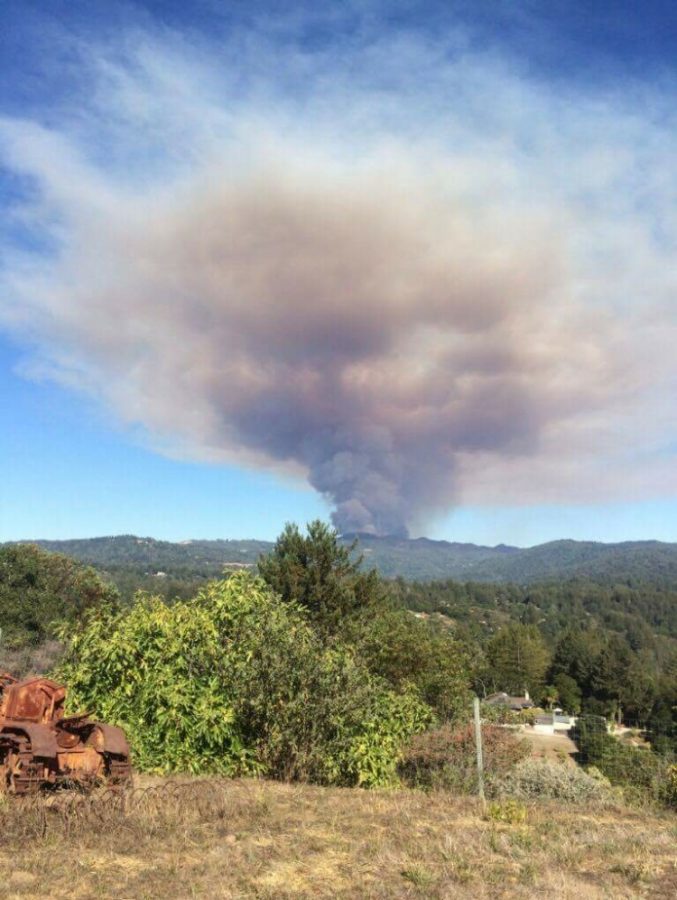Wildfires sweep the Valley: Fires burn for two weeks, destroy Santa Cruz Mountain homes
A plume of smoke rises from the Santa Cruz Mountains on Sept. 26. The Loma Fire, which started in the Santa Cruz Mountains that day, has since blazed through 4,474 acres and destroyed 28 structures in its path.
October 12, 2016
Among the largest of the recent wildfires in northern California, the Loma Fire started on Sept. 26 off Loma Prieta Road in Los Gatos due to an unknown cause.
Wildfires like the Loma Fire have raged throughout California this year, another effect of climate change on the state. As of last Wednesday, the fire had affected 4,474 acres and destroyed 28 structures.
“There are three significant fires that are burning in the state right now, one of them being the Loma Fire. This is the second biggest fire in the state right now,” said Bryan Martin, an engineer at the California Department of Forestry and Fire Protection, also known as Cal Fire. “There’s been threat to residences, critical power infrastructure, wildlife and endangered species, watershed and cultural and heritage resources.”
Another recent major wildfire, the Soberanes Fire, began on July 22 in Garrapata State Park in Carmel-By-The-Sea due to an illegal campfire in the park. The fire had affected 132,092 acres as of last Wednesday, with an estimated containment date of Saturday.
“The [Loma] Fire did not really affect my daily life. The wind was really blowing away from Santa Cruz, so I could see the fire and the red glow over the hill but no smoke. The smoke from the Soberanes Fire in August affected us a lot more,” said world history teacher Mark Janda, who lives in Santa Cruz. “For the Soberanes Fire, I have a family member who worked 27 out of 28 days evacuating animals from people’s homes, so that was a big deal and just being concerned about a family member who was in the midst of things.”
As of Wednesday, the Loma Fire was 94 percent contained, while the Soberanes Fire was 96 percent contained. However, wildfires like these have affected upper school students, teachers and families who live near fire-prone areas.
“The road my house is on has been being used for people evacuated to Soquel High School, which is not very far from my house,” Alexandra Michael (11) said. “It’s impacted my stress levels a bit, like I’m more stressed now than when the fire wasn’t going on just because the fact that it’s out there is just a strain, but it hasn’t really changed how I live my life.”
Cal Fire lifted all evacuation orders and road closures in Santa Clara County due to the Loma Fire last Tuesday. Previously, residents of the Loma Prieta area had been relocated to evacuation centers in Santa Cruz, Morgan Hill and Santa Clara County.
“At one point, there were 325 structures that were threatened [by the Loma Fire],” Martin said. “We had over 2,000 personnel working on the fire. The biggest impact I think have been the evacuations in the local communities and such—people not being able to get into their homes.”
According to the U.S. Drought Monitor, 83.59 percent of California is in drought, and 42.80 percent of the state is in extreme or exceptional drought. Such hot, dry conditions increase the dryness of soils and extend the annual fire season, allowing fires to grow in intensity more easily and to burn for longer periods of time.
“The rising of the heat can cause the smoke plume to go higher up into the atmosphere,” Martin said. “Our biggest concern is after the fire is out and all that brush and vegetation has been burned away, we know there are areas that, when the rains come in, could create a flood hazard or a wipeout or stuff like that, so we try to mitigate those and we put in water bars and do a lot of erosion control in preparation and in advance.”
Although fire is an important part of the Californian ecosystem, wildfires near populated areas caused by climate change can adversely affect buildings, air quality, recreation areas and water, impacting human living.
This piece was originally published in the pages of The Winged Post on October 10, 2016.


















![“[Building nerf blasters] became this outlet of creativity for me that hasn't been matched by anything else. The process [of] making a build complete to your desire is such a painstakingly difficult process, but I've had to learn from [the skills needed from] soldering to proper painting. There's so many different options for everything, if you think about it, it exists. The best part is [that] if it doesn't exist, you can build it yourself," Ishaan Parate said.](https://harkeraquila.com/wp-content/uploads/2022/08/DSC_8149-900x604.jpg)




![“When I came into high school, I was ready to be a follower. But DECA was a game changer for me. It helped me overcome my fear of public speaking, and it's played such a major role in who I've become today. To be able to successfully lead a chapter of 150 students, an officer team and be one of the upperclassmen I once really admired is something I'm [really] proud of,” Anvitha Tummala ('21) said.](https://harkeraquila.com/wp-content/uploads/2021/07/Screen-Shot-2021-07-25-at-9.50.05-AM-900x594.png)







![“I think getting up in the morning and having a sense of purpose [is exciting]. I think without a certain amount of drive, life is kind of obsolete and mundane, and I think having that every single day is what makes each day unique and kind of makes life exciting,” Neymika Jain (12) said.](https://harkeraquila.com/wp-content/uploads/2017/06/Screen-Shot-2017-06-03-at-4.54.16-PM.png)








![“My slogan is ‘slow feet, don’t eat, and I’m hungry.’ You need to run fast to get where you are–you aren't going to get those championships if you aren't fast,” Angel Cervantes (12) said. “I want to do well in school on my tests and in track and win championships for my team. I live by that, [and] I can do that anywhere: in the classroom or on the field.”](https://harkeraquila.com/wp-content/uploads/2018/06/DSC5146-900x601.jpg)
![“[Volleyball has] taught me how to fall correctly, and another thing it taught is that you don’t have to be the best at something to be good at it. If you just hit the ball in a smart way, then it still scores points and you’re good at it. You could be a background player and still make a much bigger impact on the team than you would think,” Anya Gert (’20) said.](https://harkeraquila.com/wp-content/uploads/2020/06/AnnaGert_JinTuan_HoHPhotoEdited-600x900.jpeg)

![“I'm not nearly there yet, but [my confidence has] definitely been getting better since I was pretty shy and timid coming into Harker my freshman year. I know that there's a lot of people that are really confident in what they do, and I really admire them. Everyone's so driven and that has really pushed me to kind of try to find my own place in high school and be more confident,” Alyssa Huang (’20) said.](https://harkeraquila.com/wp-content/uploads/2020/06/AlyssaHuang_EmilyChen_HoHPhoto-900x749.jpeg)










